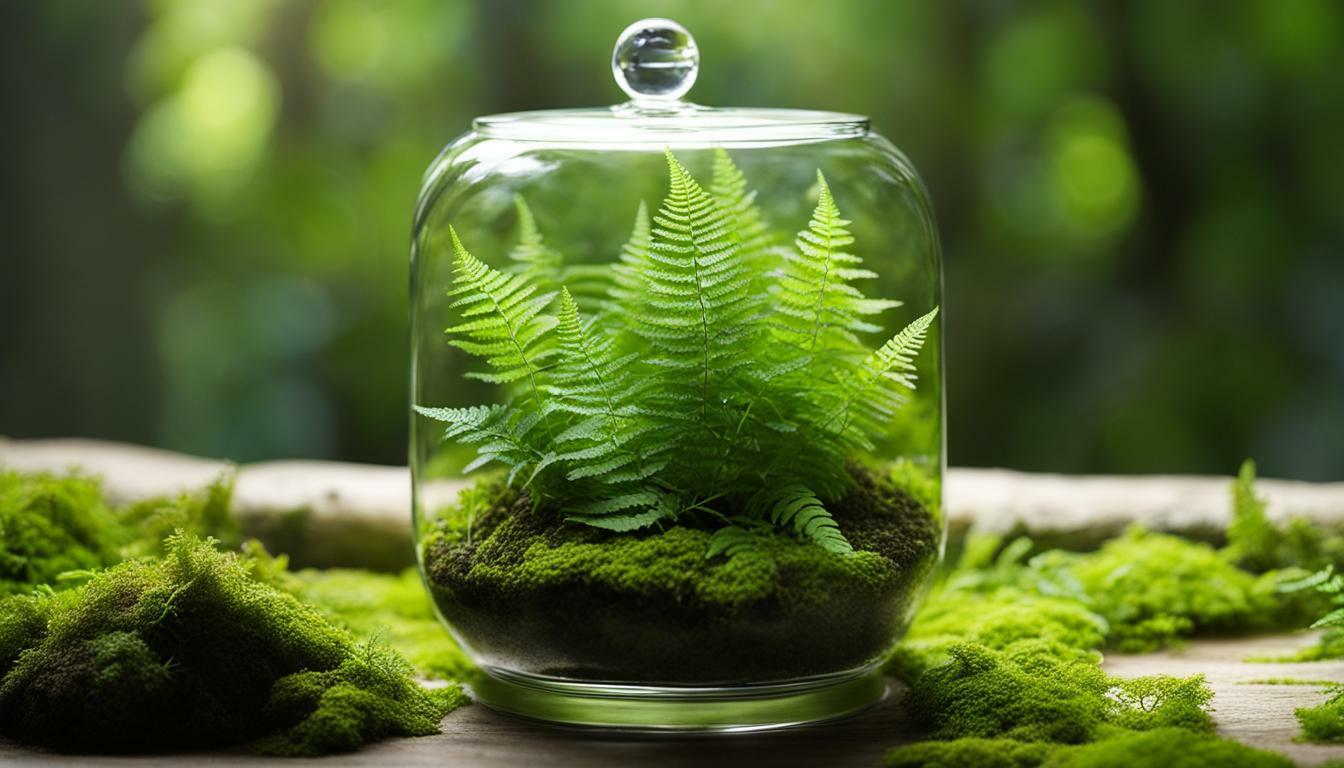Terrarium plants ferns are a popular choice for indoor gardening enthusiasts due to their low-maintenance nature and ability to thrive in a controlled environment. These miniature ecosystems bring a touch of nature into your home, and ferns are the perfect plants to create a beautiful terrarium. They come in various shapes and sizes and require minimal sunlight and water, making them easy to care for. Not only do they add a touch of green to your space, but they also have air-purifying properties, helping to improve indoor air quality. Plus, the presence of ferns in a terrarium can promote stress reduction and create a tranquil atmosphere.
Key Takeaways:
- Terrarium plants ferns are low-maintenance and suitable for indoor gardening.
- Ferns thrive in a controlled environment with minimal sunlight and water.
- They have air-purifying properties and can improve indoor air quality.
- Ferns in a terrarium can promote stress reduction and create a tranquil atmosphere.
- Popular terrarium fern choices include Rabbit Foot Fern, Bird’s Nest Fern, and Silver Lace Fern.
Choosing the Best Ferns for Terrariums
When selecting ferns for your terrarium, it’s essential to choose the right species that can thrive in the low-light conditions typically found in these miniature ecosystems. Ferns are known for their ability to adapt to shaded areas, making them ideal for terrariums. Here are some of the best fern species for terrariums:
- Rabbit Foot Fern (Davallia fejeensis): With its furry rhizomes resembling rabbit feet, this fern adds a unique touch to any terrarium.
- Bird’s Nest Fern (Asplenium nidus): This fern features stunning bright green fronds that unfurl in a graceful nest-like shape.
- Silver Lace Fern (Pteris ensiformis): Known for its delicate silver foliage, this fern creates an elegant look in terrariums.
- Crocodile Fern (Microsorum musifolium): This fern gets its name from its textured fronds that resemble crocodile skin.
Other excellent choices include Staghorn Fern, Heart Fern, Button Fern, Silver Ribbon Fern, Delta Maidenhair Fern, Boston Fern, Autumn Fern, and Lemon Button Fern. These ferns come in various shapes and sizes, allowing you to create a visually appealing and diverse terrarium.
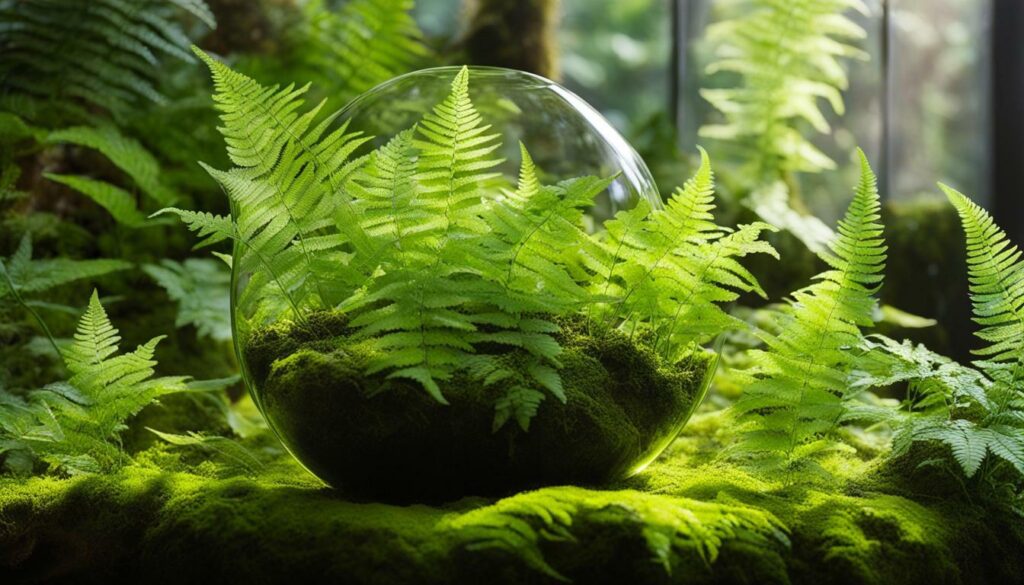
Considerations for Choosing Ferns
When selecting ferns for your terrarium, it’s important to consider their size, frond size, and planting type. Some ferns spread horizontally, making them ideal for foreground planting, while others grow tall and make excellent background plants. You should also ensure that the ferns you choose are suitable for low-light conditions, as terrariums often have limited exposure to natural sunlight.
Creating a harmonious combination of fern species in your terrarium will not only enhance its aesthetics but also provide a balanced ecosystem for the plants. By carefully selecting the best ferns for terrariums, you can create a lush and captivating miniature world in your home.
| Fern Species | Characteristics |
|---|---|
| Rabbit Foot Fern | Furry rhizomes resembling rabbit feet |
| Bird’s Nest Fern | Bright green fronds in a nest-like shape |
| Silver Lace Fern | Delicate silver foliage |
| Crocodile Fern | Textured fronds resembling crocodile skin |
| Staghorn Fern | Distinctive staghorn-like fronds |
| Heart Fern | Heart-shaped fronds |
Creating a harmonious combination of fern species in your terrarium will not only enhance its aesthetics but also provide a balanced ecosystem for the plants.
Creating the Perfect Terrarium Environment
To ensure the successful growth of your terrarium plants ferns, it’s crucial to create a humid and tropical-like environment that mimics their natural habitat. Tropical ferns thrive in high humidity levels, so it’s important to provide them with the right conditions.
One way to create a humid environment is by using a glass or plastic terrarium container with a lid. This helps to trap moisture inside and maintain the humidity levels needed for the ferns to flourish. Additionally, placing a tray of water or a small humidifier near the terrarium can help to increase humidity.
Another important aspect is choosing smaller fern varieties that are well-suited for limited spaces. These small ferns are perfect for terrariums as they don’t grow too large, allowing them to fit comfortably within the container. Some popular choices include Maiden Hair Fern, Button Fern, and Miniature Boston Fern.
| Fern Species | Size | Light Requirements |
|---|---|---|
| Maiden Hair Fern | Small | Low to medium |
| Button Fern | Small | Low to medium |
| Miniature Boston Fern | Small | Medium |
Creating the ideal terrarium environment for your ferns is key to their overall health and growth. By ensuring proper humidity levels and selecting the right fern species, you can create a miniature tropical oasis right in your home.
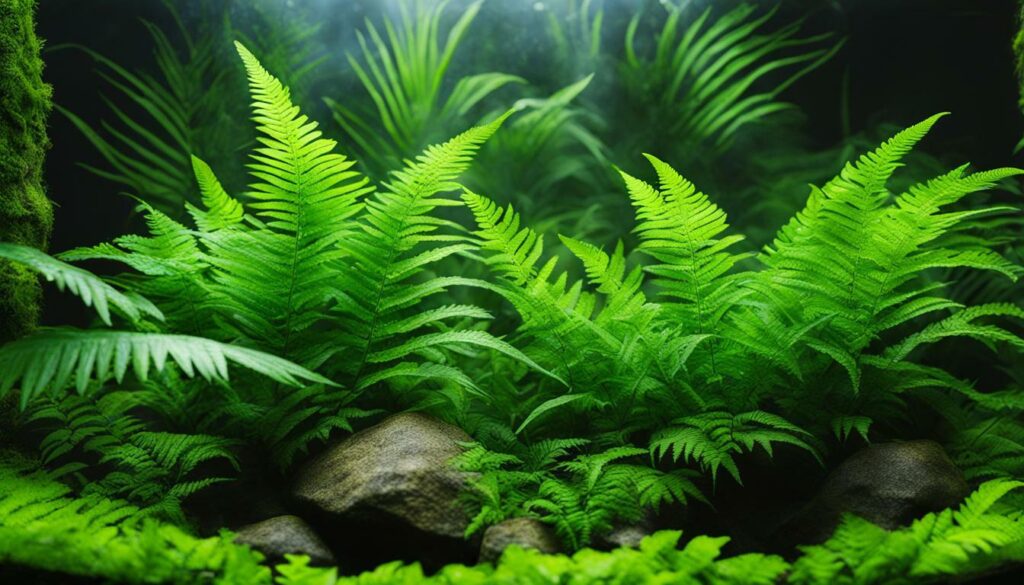
Before planting your ferns in a terrarium, it’s important to gather the essential supplies, such as a suitable container and the right type of substrate. The container you choose should be appropriate for the size and growth habit of your ferns. Consider factors like drainage, ventilation, and accessibility for maintenance. A glass container with a removable lid or a terrarium specifically designed for ferns are ideal options. The transparent nature of these containers allows for easy observation of the plants and creates a visually appealing display.
The next crucial supply is the substrate, which serves as the growing medium for your ferns. Ferns prefer a moist and well-draining substrate that mimics their natural habitat. A mixture of peat moss, perlite, and sand provides the ideal conditions, promoting root health and preventing waterlogged soil. This substrate combination ensures proper aeration and moisture retention, allowing ferns to thrive in the terrarium environment. Fill the container with the substrate, leaving enough space for planting and growth.
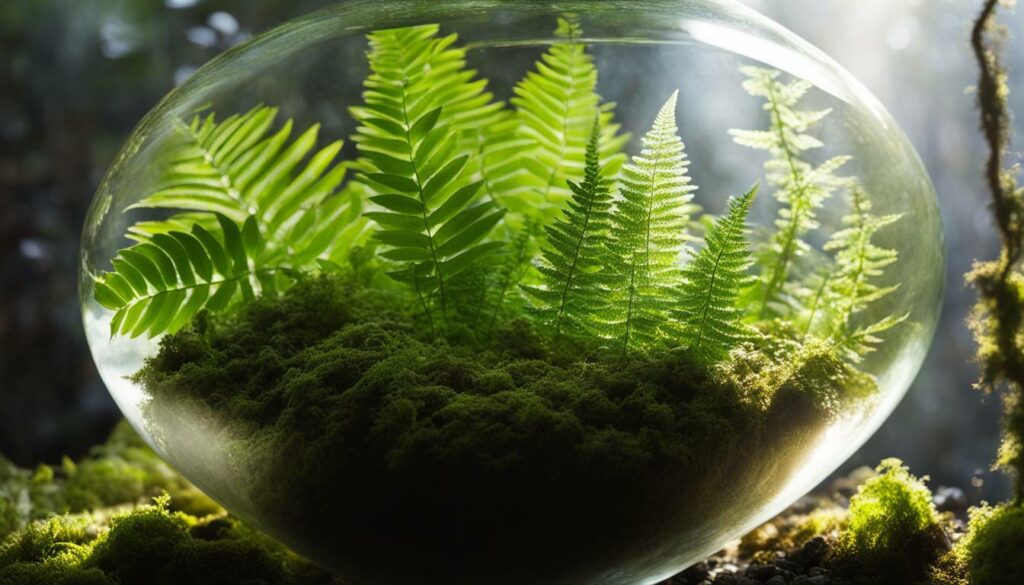
Finally, a spray bottle is an essential tool for watering your terrarium ferns. Unlike traditional watering methods, spraying the plants mimics the misting effect that ferns receive in their natural forest environment. This gentle method helps maintain the required humidity levels and prevents overwatering. Fill the spray bottle with distilled water and mist the ferns regularly, ensuring that the substrate remains consistently moist but not saturated.
Supplies Checklist:
- Suitable terrarium container with drainage and ventilation
- A combination of peat moss, perlite, and sand for the substrate
- A spray bottle filled with distilled water for misting
By gathering these essential supplies, you are setting the stage for successful terrarium plant care and providing the optimal conditions for your ferns to flourish in their miniature ecosystem.
Preparing the Terrarium Interior
To create a suitable growing environment for your ferns, it’s essential to prepare the terrarium interior by incorporating materials like moss and tree-fern fibre. These components help in creating a humid environment and provide the necessary moisture retention for your ferns to thrive.
Moss is a versatile material that can be used to line the bottom of the terrarium. It not only adds a natural touch to the overall aesthetic but also helps in retaining moisture and maintaining a stable humidity level. Additionally, moss acts as a natural filter, absorbing and purifying excess water, preventing waterlogging that can be harmful to ferns.
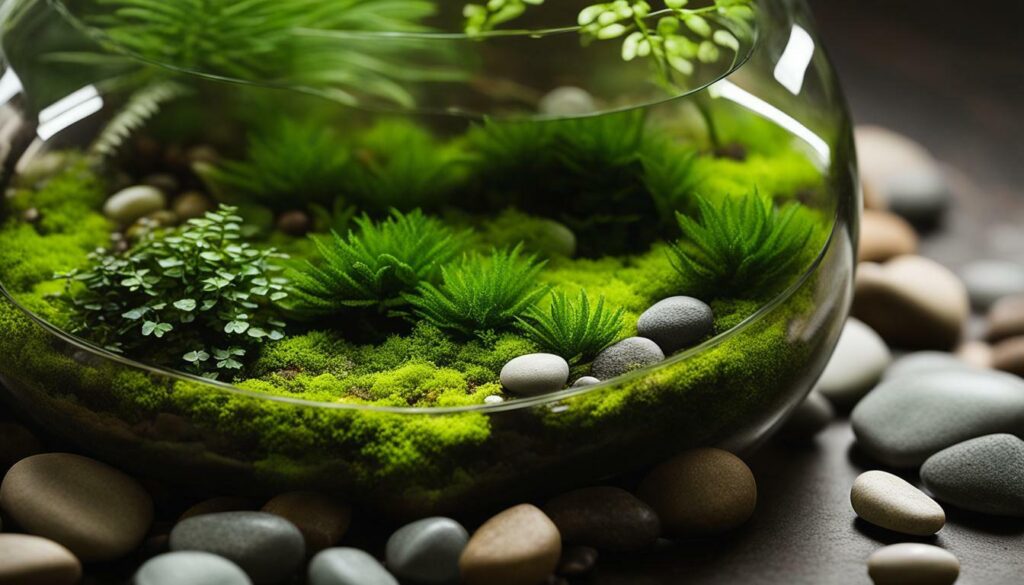
Tree-fern fibre is another excellent choice for creating a suitable environment for your terrarium ferns. It mimics the natural habitat of ferns, providing them with the ideal conditions for growth. The fibrous texture of tree-fern fibre helps in moisture absorption and retention, promoting healthy root development for your ferns.
When adding moss and tree-fern fibre to your terrarium, ensure even distribution and layering for optimal moisture control and enhanced aesthetics. The combination of these materials creates a perfect balance between moisture retention and drainage, creating an ideal environment for your ferns to flourish.
| Benefits of Incorporating Moss and Tree-Fern Fibre |
|---|
| Maintains stable humidity levels |
| Enhances moisture retention |
| Promotes healthy root development |
| Acts as a natural filter |
| Provides a natural and aesthetic appeal |
Expert Tip:
“When incorporating moss and tree-fern fibre into your terrarium, make sure to choose high-quality materials free from contaminants. This helps in preventing the growth of unwanted fungi and ensures a healthy environment for your ferns.”
Planting and Watering Terrarium Plants Ferns
Once your terrarium is prepared, it’s time to plant your ferns and establish a watering routine to ensure their proper growth. Ferns are delicate plants that thrive in moist environments, so it’s important to provide them with adequate hydration. A spray bottle is an ideal tool for watering ferns in a terrarium as it allows you to control the amount of water and maintain the desired humidity levels.
Start by gently removing the ferns from their nursery pots and carefully loosening the roots. Create small holes in the substrate using your fingers or a small tool, ensuring that they are deep enough to accommodate the roots of the ferns. Place the ferns into the holes and gently press the substrate around the roots to secure them in place.
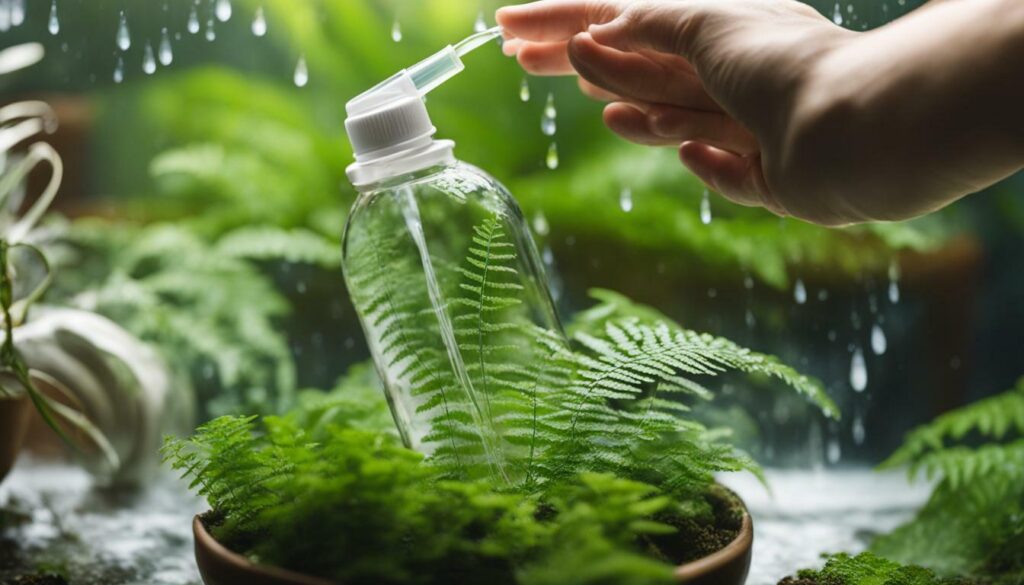
After planting the ferns, mist the leaves and the soil using the spray bottle. This will help to create a humid environment for the ferns to thrive. It’s important to avoid overwatering, as excessive moisture can lead to root rot. Monitor the moisture level of the substrate by touching it with your finger. If it feels dry to the touch, it’s time to water the ferns again.
Establish a watering routine based on the specific needs of your ferns and the conditions within your terrarium. Some ferns require more frequent watering, while others can tolerate drying out slightly between waterings. Pay attention to any signs of stress in your ferns, such as wilting or yellowing leaves, as these may indicate that adjustments need to be made to your watering routine.
Providing Nutrients and Optimal Conditions
To promote the optimal growth of your terrarium plants ferns, it’s crucial to provide them with the necessary nutrients and ensure favorable environmental conditions. Ferns are relatively low-maintenance plants, but they still require specific care to thrive in a terrarium. Here are some key factors to consider:
Nutrients:
Ferns in a terrarium benefit from regular fertilization to replenish essential nutrients in the soil. Choose a balanced liquid fertilizer specifically formulated for indoor plants. Apply the fertilizer according to the instructions provided, usually once a month during the growing season. Be mindful not to over-fertilize, as this can lead to leaf burn and other complications.
Additional Heat:
While terrariums create a controlled microclimate, some fern species may require additional heat to flourish. Consider using a heating mat or placing the terrarium near a heat source, such as a radiator or heat lamp. Monitor the temperature closely and adjust accordingly, taking care not to subject the ferns to extreme heat that could damage them.
Lighting:
Ferns thrive in indirect or filtered light, as direct sunlight can scorch their delicate leaves. However, if your terrarium doesn’t receive sufficient natural light, consider supplementing it with artificial lighting. LED grow lights are a popular choice for providing the right spectrum and intensity of light to support fern growth. Position the lights above the terrarium and adjust the duration of illumination based on the specific needs of your ferns.
By providing the necessary nutrients and optimizing the environmental conditions, you can ensure that your terrarium plants ferns thrive and bring beauty to your living space. The combination of proper care, suitable growing conditions, and your love and attention will result in healthy, vibrant ferns that enhance the ambiance of your terrarium.
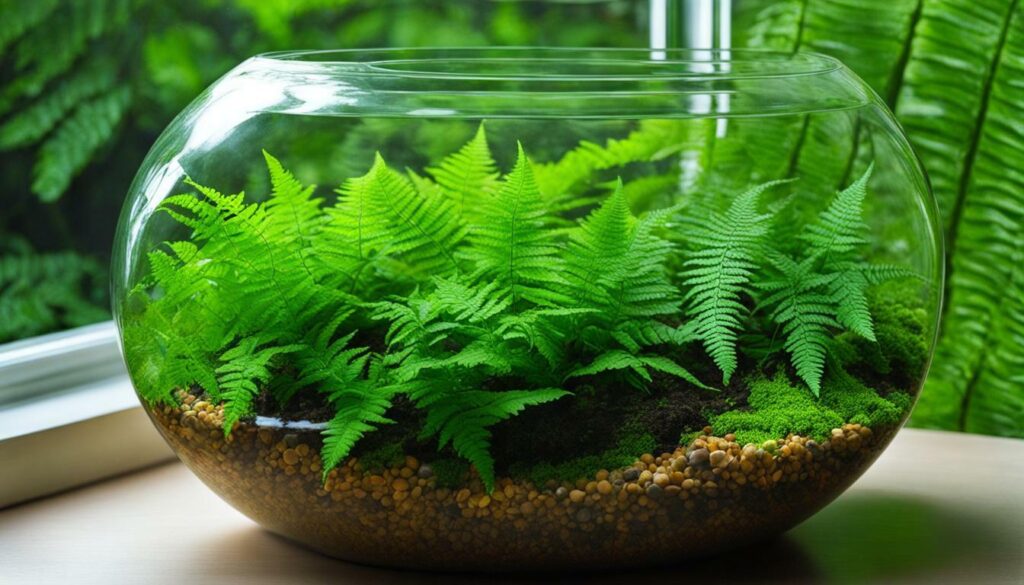
Keeping your terrarium plants ferns pest-free and exploring propagation methods are important aspects of maintaining a healthy terrarium. While ferns are generally low-maintenance plants, they can still be susceptible to pests such as slugs and woodlice. If left unchecked, these pests can damage the foliage and hinder the growth of your ferns. Manual removal is the best approach in a terrarium setting, as chemical pesticides can harm the delicate balance of the ecosystem. Simply inspect your ferns regularly and remove any pests you come across. This will help ensure the health and longevity of your plants.
Propagation is another fascinating aspect of growing ferns in a terrarium. It allows you to expand your collection and create new terrariums. There are two primary methods of propagation: division and spores. Division involves separating the fern into multiple plants, each with its own root system. This is best done during repotting when the fern has outgrown its current container. Spore propagation, on the other hand, requires a bit more patience. Ferns produce tiny spores on the undersides of their fronds. Collect these spores and sow them on a suitable growing medium, such as sphagnum moss. With time and proper care, the spores will develop into new ferns, ready to be planted in their own terrarium.
Propagation Methods for Terrarium Plants Ferns:
| Propagation Method | Description |
|---|---|
| Division | Separating the fern into multiple plants with their own root systems. |
| Spores | Collecting and sowing tiny spores to grow new ferns. |
To successfully propagate ferns in a terrarium, provide the right conditions such as high humidity and proper lighting. Maintain a consistent moisture level in the growing medium and ensure good air circulation to prevent the growth of mold or fungus. Patience is key when it comes to propagation, as it can take several weeks or even months for new ferns to develop from spores. However, the reward of watching these delicate plants grow and thrive is well worth the wait.
So, whether you’re battling pesky pests or exploring the fascinating world of fern propagation, these aspects of terrarium plant care will help you maintain a flourishing terrarium. By ensuring a pest-free environment and experimenting with propagation methods, you’ll be able to enjoy the beauty and benefits of terrarium plants ferns for years to come.
The Beauty and Benefits of Terrarium Plants Ferns
Beyond their visual appeal, terrarium plants ferns offer numerous benefits, including air purification, stress reduction, and improvement of indoor air quality. These delicate and graceful plants have the ability to filter toxins from the air, releasing fresh oxygen and creating a healthier environment inside your home. As they absorb carbon dioxide and other pollutants, they contribute to improving indoor air quality, making them an excellent choice for those concerned about their well-being.
Stress reduction is another advantage of having terrarium plants ferns. Their lush green foliage and soothing presence help create a calming atmosphere, providing a sense of tranquility and relaxation. Research has shown that being surrounded by natural elements, such as ferns, can have a positive impact on mental well-being, reducing stress levels and promoting a sense of peace.
To fully enjoy the air-purifying properties and stress-reducing benefits of ferns in a terrarium, it’s important to choose the right varieties. Some ferns, such as the Boston Fern, are known for their exceptional air-purifying abilities and are suitable for terrariums. Others, like the Staghorn Fern, can add a unique touch to your miniature ecosystem with their striking fronds. The varied shapes, sizes, and textures of these ferns make them ideal for creating visually captivating terrariums.

Incorporating terrarium plants ferns into your indoor space not only enhances its aesthetic appeal but also brings nature closer to you, providing multiple health benefits. By purifying the air, reducing stress, and improving indoor air quality, these ferns contribute to creating a harmonious and healthy living environment. Whether you choose a simple tabletop terrarium or a larger showcase piece, the addition of ferns will undoubtedly elevate the beauty and value of your miniature green oasis.
Conclusion
By following the tips and guidelines outlined in this guide, you can create a thriving mini ecosystem with terrarium plants ferns and enjoy their natural beauty in your indoor space. Terrarium ferns are the perfect choice for bringing nature into your home, as they are low-maintenance plants that require minimal sunlight and water. Not only do they add aesthetic value to your terrarium, but they also have air-purifying properties and can help reduce stress while improving indoor air quality.
When choosing ferns for your terrarium, consider their size, frond size, and planting type. Some popular choices include Rabbit Foot Fern, Bird’s Nest Fern, Silver Lace Fern, Crocodile Fern, Staghorn Fern, Heart Fern, Button Fern, Silver Ribbon Fern, Delta Maidenhair Fern, Boston Fern, Autumn Fern, and Lemon Button Fern.
Growing ferns in a terrarium requires the right supplies, including a suitable terrarium container, substrate, and a spray bottle for watering. Proper preparation of the interior is also important, which involves incorporating materials like moss and tree-fern fibre. Regular watering and providing nutrients are essential for fern growth, and depending on the ambient conditions, additional heat and/or lighting might be necessary. If pests like slugs and woodlice are present, manual removal is recommended. Ferns can also be propagated through division or spores, allowing for expansion of your terrarium.
In conclusion, terrarium plants ferns offer beauty, versatility, and numerous benefits. With their low-maintenance nature and ability to enhance the indoor environment, these plants are an excellent choice for creating a captivating mini ecosystem. So go ahead, embrace the serenity and charm of terrarium ferns in your home.
Can I Use the Same Guide for Growing Ferns in a Terrarium for Indoor and Outdoor Gardening?
Yes, you can use the same guide for growing ferns in a terrarium for indoor and outdoor gardening with ground ferns. These hardy, low-maintenance plants thrive in both environments, as long as you provide the right conditions, such as moist soil, indirect sunlight, and adequate drainage.
FAQ
What are the best ferns for terrariums?
Some popular choices for ferns in terrariums include Rabbit Foot Fern, Bird’s Nest Fern, Silver Lace Fern, Crocodile Fern, Staghorn Fern, Heart Fern, Button Fern, Silver Ribbon Fern, Delta Maidenhair Fern, Boston Fern, Autumn Fern, and Lemon Button Fern.
What supplies do I need for growing terrarium plants ferns?
You will need a suitable terrarium container, substrate for planting, and a spray bottle for watering. Other supplies may include moss and tree-fern fibre for the terrarium interior.
How should I prepare the interior of the terrarium?
Incorporate materials like moss and tree-fern fibre to create a suitable growing environment for the ferns. These components help maintain moisture levels and provide a favorable habitat for ferns.
How often should I water my terrarium plants ferns?
Ferns in a terrarium should be watered regularly, keeping the soil moist but not overly saturated. It is recommended to use a spray bottle to water the plants and maintain humidity levels.
What conditions do ferns in a terrarium require?
Ferns in a terrarium require a humid environment and moderate indirect sunlight. Additional heat and lighting may be necessary depending on the ambient conditions in your home.
How can I deal with pests in my terrarium?
If pests like slugs and woodlice are present in your terrarium, they should be manually removed. Regular inspection and maintenance can help keep pest infestations under control.
Can ferns in a terrarium be propagated?
Yes, ferns can be propagated in a terrarium through division or spores. This allows for the expansion of your fern collection and the creation of new terrariums.
What are the benefits of having terrarium plants ferns?
Terrarium plants ferns have air-purifying properties, can reduce stress, and improve indoor air quality. They also add beauty and a touch of nature to your home decor.

